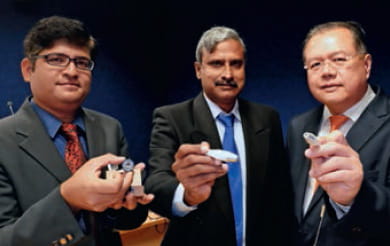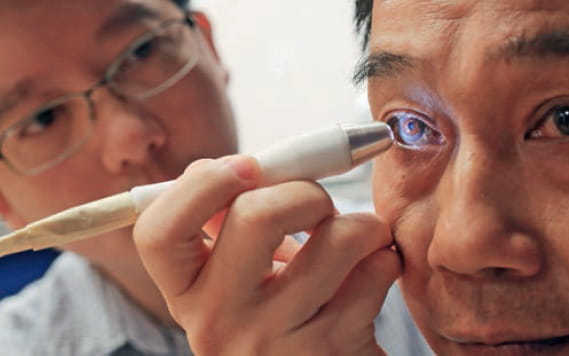Stories > A Matter of Foresight
A Matter of Foresight
An international team based in Singapore’s top research institutes has unveiled an invention that can significantly help in the global fight against glaucoma.
BY HWEE HWEE TAN
PHOTOS THE STRAITS TIMES/ SPH
hanks to a new invention created by an international team of researchers and clinicians from Nanyang Technological University (NTU) and the Singapore Eye Research Institute (SERI), glaucoma diagnosis is now nearly 80 per cent cheaper and more than twice as fast, with greater comfort for patients.
Enter the GonioPEN, a pen-size camera that takes high-resolution photos of the eye’s drainage canal. A software is then used to analyse the images, helping doctors and eye specialists with their diagnosis. The invention was unveiled in April 2018.
Known as a leading cause of blindness around the world, glaucoma affects around 3 to 4 per cent of the population above the age of 40 in Singapore. However, an estimated 70 per cent of these Singaporeans are undiagnosed.
This is because a gonioscopy – the common practice of diagnosing glaucoma – takes about 15 minutes and requires an expert specialist, so clinics don’t usually include it in their routine eye checks. It also doesn’t help that the procedure involves pressing a glass scope against the eyeball, which can cause discomfort to the patient.
With the GonioPEN, diagnoses can be made faster and medical technicians can operate the device with minimal training.
INCUBATING IDEAS TOGETHER
Led by two professors from India, Prof Murukeshan Matham from NTU and Prof Mani Baskaran from SERI, the research collaboration unfolded over a period of two years.
The idea for the device was formulated by Prof Mani, who during his clinical practice was finding solutions for a lack of documentation for the gonioscopic test.
What started as a simple photographic tool later took on the shape of a diagnostic one. As the research team comprised members from India, Singapore and Malaysia, working together across different geographic boundaries was initially challenging. Despite the fact that most of the international researchers had already been based in Singapore for several years and were familiar with the local culture, they still had to adapt to one another’s different working styles.
“The Development Of The Goniopen Is A Significant Contribution In Combating Glaucoma, As Early Diagnosis Can Help Stop The Disease From Leading To A Loss Of Sight.”
“The Singaporean researchers took a more theoretical approach while the Indian researchers – who are backed by industry experience – were more hands-on, preferring to jump in first and refine things later,” shares Jesmond Hong, a Singaporean researcher formerly from NTU. After a period of adjustment, however, things began to fall into place.
“We eventually found that we could use our different approaches to complement one another, tapping on all of our strengths to achieve balance. This accelerated the project’s completion,” says Hong.
|
SERI's Prof Mani holds the gonioscope that is currently used to detect the type of glaucoma,While NTUʼs Prof Murukeshan and SERI executive director Prof Aung Tin hold the GonioPEN. |
Similarly, working with the Singapore researchers was a fruitful experience for Prof Mani, who praises their high level of discipline. “They delegated responsibilities clearly and got the work done on time. The most important thing in research is to be truthful, and Singapore students are sincere and honest. If they don’t understand something, they ask questions and spend time learning from you,” says Prof Mani. According to him, having a set of tight guidelines in place was a boon to the project, which was supported by grants from the National Medical Research Council and the National Research Foundation Singapore. |
“Though some may find Singapore’s rules strict, I discovered that it is able to be flexible within those rules,” he shares. For instance, though the team was given a budget, they were allowed concessions for any surprises.
“We Found That We Could Use Our Different Approaches To Complement One Another, Tapping On Additional Strengths To Achieve Balance. This Accelerated The Project's Completion.”
Jesmond Hong, Researcher, Formerly From Nanyang Technological University
BONDING THROUGH CULTURE
But perhaps some of the most memorable experiences for the researchers took place outside the laboratory. Hong shares that he is thankful for the insights into Indian culture, which he gained through celebrating festivals with his teammates.
“I appreciate how Prof Murukeshan took the time to explain the Hindu harvest festival of Onam, which is celebrated by the people of Kerala, like himself. His wife even prepared special traditional snacks for us to share,” he says.
Needless to say, food and festivity bonded the team, and Prof Murukeshan attended the wedding of one his Singaporean Chinese students, while Prof Mani recalls many a tasty meal shared with his colleagues.
|
The GonioPEN makes the diagnosis process more efficent. |
“Most of our ideas were sparked over chicken rice in Margaret Drive. Bonding over things such as the lo hei during Chinese New Year translated into cohesive collaboration, sans the stress and ego,” says Prof Mani. To him, having so many opportunities for cultural exchange is unique to the Singapore workplace. “Culturally speaking, it was easy for me to adapt to the Singaporean researchers as we have many things in common. Things like discipline, respect for the elderly and care for colleagues are all virtues that we share,” adds Prof Mani. |
STEPPING STONE
The two years of successful collaboration resulted in the development of the GonioPEN – a significant contribution in combating glaucoma, as early diagnosis can help stop the disease from leading to loss of sight.
Moving forward, Prof Mani hopes that the invention can be incorporated into routine eye checks, to improve the detection of glaucoma in patients. Plans are in the pipeline to commercialise the product over the next few years, and patents have been filed for the GonioPEN by NTU’s innovation and enterprise arm, NTUitve.
“We started the project because we wanted to help mankind. I believe the GonioPEN can really do wonders for the diagnosis of glaucoma worldwide,” concludes Prof Murukeshan.


